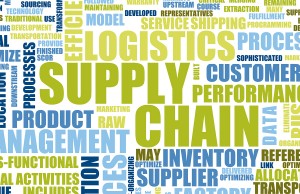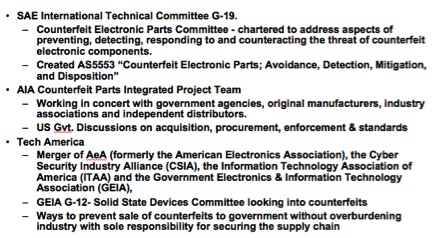2012-12-24 In a discussion with Denton Clark of Lockheed Martin, the focus was upon how to meet the challenge of counterfeit parts in the supply chain.
Denton Clark, an AIT Manager, is the Automated Identification and Data Capture (AIDC) Integrated Process Team (IPT) lead, for Lockheed Martin Corporation. In this position, Mr. Clark has the overall responsibility for supporting the AIDC development and implementation efforts across the Corporation. This includes a broad range of ongoing and prospective activities including ensuring the DoD Passive RFID Policy is compliantly implemented as well as integrating AIDC technologies horizontally across the corporation. In addition, Mr. Clark is responsible for assisting existing and prospective programs in evaluating and implementing AIDC technologies as a supply chain transformation tool. Denton’s team has been working closely with the Office of the Secretary of Defense and the Defense Logistics Agency in the development and implementation of Passive RFID technology in compliance with the Department of Defense’s Passive RFID initiative.
Because the counterfeit parts challenge is inextricably intertwined with shaping an effective and secure manufacturing process, quite obviously building a new manufacturing approach and capability like the F-35 has to be built from the ground up with significant attention to attenuating the counterfeit parts challenge.
The problem revolves largely around the use of brokers to provide parts for systems as they age.
Programs early in their production cycle are in the hands of the Original Equipment Manufacturers or OEMS, and as they age, more of the parts provisions come from brokers, rather than OEMS, and this is where the problem becomes its most significant.
How will the F-35 program cope with the problem? And to best shape solutions which attenuate the problem?
In other words, countering the counterfeit parts challenge is a key element of shaping a defense manufacturing approach going forward.
And as the U.S. builds safeguards in the F-35 as a global program, the U.S. and its partners are in a position to more effectively risk mitigate the challenge.

SLD: How would you characterize the challenge of counterfeit parts in the defense industrial supply chain?
Clark: It is best to start with the baseline legislation which lays out the approach to dealing with the problem. This baseline legislation is to be found in the National Defense Authorization Act 2012, Section 8:18.
NDAA FY2012 Sec 818 Counterfeit Parts Legislation
The act focuses on a number of elements.
It is important to identify the source of the product, and to work with trusted suppliers.
There is a clear need to track the physical flow of the product itself: where has it been, where is it going, and then track the financial responsibility for the product itself.
From DOD’s perspective, what they care about is who had financial ownership of the product itself, and that would generally be the prime contractor or their distributer.
What is important here is to establish, and manage a chain of custody for the parts manufacturing, distribution and use.
To do so requires asset visibility.
So all of the changes we talked about last time associated with the UID process are part of providing for greater asset visibility. And such visibility is a means to the end of risk mitigation in the quality of the parts, their performance and reliability, and to attenuate the risk of counterfeits.
SLD: So meeting the challenge of identifying and eliminating counterfeit parts is part and parcel of shaping a more effective manufacturing and sustainment process. And this process is founded on greater asset visibility and transparency?
Clark: It is.
We are looking at a number of technologies to enhance our capability to deal with the counterfeit parts challenge.
Each of these technologies has their strengths and weakness, but all contribute to thinking about ways to mitigate risk from counterfeit parts.
There are three key technologies in play here: laser etching, biometric DNA markers, and frequency spectrum projection.
The first technology is laser etching. This is a new technology whereby laser can etch information into chips and parts, e.g. UIDs which contain a lot of information.
https://www.lia.org/laserinsights/2011/10/12/high-speed-laser-engraving-in-anti-counterfeiting/
The second is biometric DNA markers. With this technology, when you put ink on a product, it would have its own unique DNA markers and its either going to be present or not. If its there, it is authentic. If its not, it is counterfeit.
http://spectrum.ieee.org/semiconductors/devices/plant-dna-vs-counterfeit-chips/
The third one and the most promising technology for dealing with counterfeit electronic equipment is the use of frequency spectrum technology. With this technology, when you turn on a piece of electronic equipment, the equipment radiates spectrum at a certain frequency. When the product is new it radiates at a certain spectrum, but degrades over time.
You can get a sense of age and whether it works and can determine if something is not real inside that product. You can build a library of these spectrums for a given piece of equipment.
SLD: This is clearly not just a Lockheed Martin initiative, but is DOD and industry wide.
Clark: Lockheed Martin certainly has been a leader in working with trusted suppliers, and this approach is a centerpiece of the F-35 program.
But industry and the government are taking a number of initiatives, and crafting standards to deal with these challenges.
QUESTION: This is not just a defense industrial problem, but occurs throughout modern industrial supply chains, and it is not just industry which is involved in dealing with the problem, but the government itself.
Clark: A good example of this problem is Defense Logistics Agency.
DLA is a huge customer to many defense contractors. For Lockheed Martin, DLA is our second largest supplier for all our sustainment programs. But there are no provisions in the law to hold any government entity responsible for passing on counterfeit parts.
It is clear that we – both industry and the government – share in the problem and all have an imperative to fix the problem. . We certainly do not under any circumstances want a part that is not perfectly conforming to its requirements to be put in any of the systems that we manufacture.
SLD: The problem is augmented as a platform is older and the role of the OEM is reduced and parts brokers become more important in the sustainment process. Could you talk to this issue?
Clark: That is precisely the challenge. The goal of having trusted suppliers is that you’ve got to be comfortable that that supplier is flowing down the same requirements to their suppliers all the way to the source of the product itself.
We have programs within Lockheed Martin where we can trace right back to the mine where that copper came from in the wires, so that’s how far back we can go.
For example, there are only two places in the world that you can get industrial grade or military grade titanium, and one of those places is in Russia and the other is China.
In a program like 787, A-380s, the F-35s, any program that’s using titanium, your manufacturers want to know where that material is being mined.
Once it’s been through a foundry, then you’ve got to do the structural testing to figure out what the grade is, so you want to do your sourcing.
You want to know where it came from right from the mine and so anti-counterfeiting is not just going down through suppliers, sometimes it’s going right to the source. The quality of your silicon sometimes will matter.
SLD: The F-35 is a new manufacturing program.
Are there not advantages of shaping this program and its sustainment approach from the outset to do a better job of risk mitigation with regard to counterfeit parts?
Clark: It does. It is about putting in place a more reliable supply chain.
And not just for defense. DOD affects about 3% of our foreign trade but has the potential of affecting a great deal more by the way we do business. Anybody who does business with DOD will probably take the same processes their building for that supply chain and apply to all the other supply chains because it would not make sense not to. So all of a sudden counterfeiting beyond DOD becomes difficult.
It is shaping a quality assurance approach across a broad spectrum of product.
And while this is a U.S. law, the law will have a major impact on all our partner countries and anybody who participates within the F-35 program in the future.


